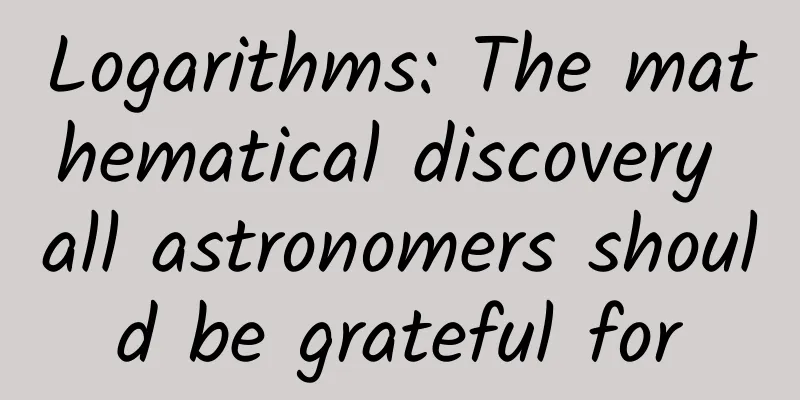Logarithms: The mathematical discovery all astronomers should be grateful for

|
Tables of logarithms have been a useful tool for scientists and engineers for centuries, and they still have great mathematical appeal today because of their close connection to exponential functions. By Richard Elwes Translations | Qi Ruihong, Fang Chao, Yu Huan For many years, many people kept tables of logarithms handy to help them with multiplication and division. In the second half of the 20th century, portable calculators eventually consigned logarithm tables to history. But fascinating discoveries in the deeper mathematical realms of series and calculus ensured that logarithms themselves would never become obsolete. In the late 1500s, John Napier began to study what he initially called “artificial numbers.” He discovered a way to turn a complex multiplication into a fairly simple addition. To find the product of two numbers, such as 4,587 and 1,962, he first calculated the artificial numbers of the two numbers and found their sum. He then reversed the sum of the two artificial numbers, calculating the original number so that its artificial number was the sum. Although this process did not involve multiplication, the result was indeed the product of the two original numbers—8,999,694. Seismographs are used to measure the intensity of earthquakes. The Richter scale, which is used internationally to measure earthquake intensity, is logarithmic: an earthquake measured as 3 is 10 times as strong as an earthquake measured as 2. Napier's logarithm Soon after, Napier gave his artificial numbers a new and better name: logarithms. Today, we understand that logarithms are just the inverse of exponentiation. Exponentiation involves multiplying a number by itself repeatedly, so "2 to the cube" means multiplying three 2s, Briggs's logarithmic table Soon after John Napier invented logarithms, Henry Briggs began to turn them into a useful tool. Since we use the decimal system to represent numbers, Briggs chose to calculate logarithms in base 10, which was convenient, and began to work on a "logarithm table" - the logarithms of all integers from 1 to 1000. Over the years, Briggs and other mathematicians generalized this table to a larger set of numbers. Of course, for most integers, their logarithms are not integers, so researchers have to give some idea of the accuracy of the logarithms they find. In the late 18th century, Gaspard de Prony supervised the production of a special mathematical table, 17 large double-sided volumes, containing the logarithms of positive integers up to 200,000, accurate to the 19th decimal place (for larger numbers, to the 24th). One of the earliest logarithm tables used in John Napier's 1614 treatise, A Description of a Curious Table of Logarithms. John Napier was working with what became known as "natural logarithms," while Henry Briggs was working with base 10 logarithms, which became known as "common logarithms." Natural logarithm Logarithms have been extremely useful to mathematicians since Napier’s discovery. As the brilliant scientist Pierre-Simon Laplace said, “The discovery of logarithms has doubled the life of astronomers by saving labor.” However, the mathematical significance of logarithms is more important and far-reaching than its use as a calculation tool. This was first realized by Pietro Mengoli in 1650. His research on series and his interest in logarithms unexpectedly combined. This alternating series has a definite limit, approximately 0.693147. Mangoli proved that this limit is the natural logarithm of 2 (usually written as In2, although pronounced log2). The natural logarithm is like any other logarithm, except that it has a special choice of base, e, which is approximately 2.71828. Indeed, it was through the natural logarithm and Mangoli's results that one of the most important functions in mathematics, the exponential function, came to prominence. Indeed, the search for more accurate tables of logarithms gave a powerful impetus to the development of the theory of abstract series. In 1668, Nikolaus Mercator published a work called On the Technique of Logarithms, in which he discovered the series formula for natural logarithms: This beautiful theorem is a generalization of Mangoli's result, which corresponds to the special case x=1. Calculus and Logarithms Mercator's theorem hinted at the "naturalness" of natural logarithms, but a fuller story is told with the calculus of Newton and Leibniz. This article is authorized to be excerpted from the 26th chapter "Logarithms" of "A Brief History of Mathematics Illustrated: 100 Major Breakthroughs You Must Know in the World of Mathematics". Special Tips 1. Go to the "Featured Column" at the bottom of the menu of the "Fanpu" WeChat public account to read a series of popular science articles on different topics. 2. Fanpu provides a function to search articles by month. Follow the official account and reply with the four-digit year + month, such as "1903", to get the article index for March 2019, and so on. Copyright statement: Personal forwarding is welcome. Any form of media or organization is not allowed to reprint or excerpt without authorization. For reprint authorization, please contact the backstage of the "Fanpu" WeChat public account. |
<<: Avocado is a calorie bomb, so why do so many people eat it to lose weight?
Recommend
New media operation: Find hot spots in 3 directions!
I was chatting with a friend recently, and she ta...
How to retain new users?
Why did we lose the users we worked so hard to ac...
Starbucks membership system disassembled!
Starbucks , a controversial brand. At the product...
The oldest European spruce in the world is called... Husky
There are several Linnaeus Trails in Uppsala, Swe...
After DeepSeek was open-sourced, major AI companies announced that they would soon open source their products: What exactly is “open source”?
With the development and popularization of artifi...
20 Social Marketing Growth Strategies for 2021
In 2021, social marketing occupies a very critica...
Encountering the "flame" of the starry sky: exploring the mystery of the sun
Produced by: Science Popularization China Author:...
The 7-seater off-road SUV Roewe RX8 may be launched in the first half of this year
Recently, the preview image of SAIC Motor's n...
Operational framework construction: Make 1 traffic flow more valuable than 4
Because I am good at building frameworks, my arti...
The hotter the foot bath water, the better? The truth is——
Review expert: Wang Xuejiang, professor of pathop...
Baidu promotion guide for the gaming industry!
The peak season for the summer gaming industry is...
Revealing the 315 hacker wifi, how to ensure APP data security?
The 315 Party exposed WIFI security, demonstrated...
How to do a good job of Zhihu marketing for a brand?
Zhihu's commercial marketing system is curren...
Global warming: A detailed explanation of the 2021 Physics Nobel Prize for complex stochastic systems
According to the official website of the Nobel Pr...
How powerful is it? Alfa Romeo 2.0T engine
Recently, Alfa Romeo has provided a new 2.0T turb...









